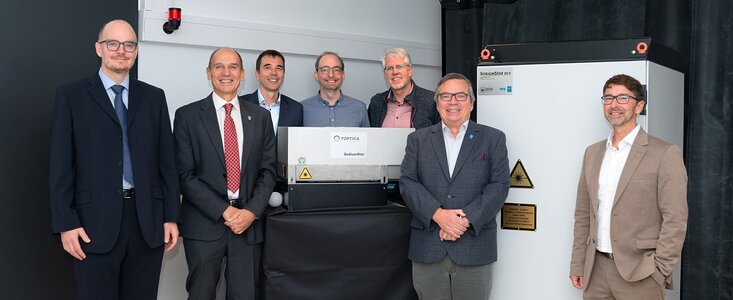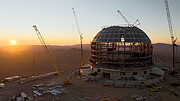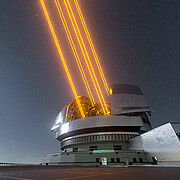Annuncio
Laser sources for ESO’s ELT and GRAVITY+ now completed
30 Settembre 2024
Today, at a ceremony near Munich, staff from ESO and German company TOPTICA celebrated the completion of the last laser source of ESO’s Extremely Large Telescope (ELT). Lasers for the GRAVITY+ upgrade to ESO’s Very Large Telescope Interferometer (VLTI) have also been completed.
The ELT will be equipped with six powerful lasers [1] that will excite sodium atoms in Earth's upper atmosphere, creating artificial stars. These ‘stars’ are used to measure the blurring caused by the atmosphere so that the ELT’s adaptive mirrors can correct for it. By employing sophisticated "adaptive-optics" systems, the telescope and its instruments can obtain sharper images than any other ground-based telescope.
TOPTICA, in partnership with the Canadian company MPB Communications Inc. (MPBC), has just completed production of a series of 9 laser sources, which generate the laser light. Six of these will be used on the ELT and three on GRAVITY+, an extensive upgrade being done to ESO’s VLTI and its GRAVITY instrument. All nine laser sources have now been completed and delivered to ESO. The recent laser production continues a successful programme of work, which started in 2009, with the goal of developing and industrialising a laser technology suitable for sodium laser guide stars at astronomical telescopes.
ESO will be responsible for integrating the laser sources with the remaining components that make up the laser guide star units. Each unit includes, in addition to the light source, a projection subunit, which expands the laser beam and directs it into the sky, and a heat exchanger, to stabilise the temperature of the laser source. Dutch organisation TNO is contracted to provide the projection subunits, while Italian company Tecoelettra has delivered the heat-exchanger units.
Similarly to the lasers on ESO’s Very Large Telescope, each of the new lasers will deliver 22 watts of yellow-orange laser light — about 4000 times the maximum allowed for a commercial laser pointer — in a beam with a diameter of 30 centimetres. Thanks to these lasers, the ELT will be able to deliver razor-sharp images all over the sky.
Once it sees first light later this decade, ESO’s ELT will allow us to peer deeper and further into the Universe than ever before. The telescope is currently under construction in Chile’s Atacama Desert.
Notes
[1] The ELT can accommodate a total of eight laser guide stars. It will be equipped with six at the time of first light, with the possibility to increase to eight lasers in the future.
Contatti
Steffan Lewis
ELT Optical Control Project Manager at ESO
European Southern Observatory
Garching bei München, Germany
Email: slewis@eso.org
Bárbara Ferreira
ESO Media Manager
Garching bei München, Germany
Tel: +49 89 3200 6670
Email: press@eso.org
A proposito dell'annuncio
| Identificazione: | ann24016 |
Our use of Cookies
We use cookies that are essential for accessing our websites and using our services. We also use cookies to analyse, measure and improve our websites’ performance, to enable content sharing via social media and to display media content hosted on third-party platforms.
ESO Cookies Policy
The European Organisation for Astronomical Research in the Southern Hemisphere (ESO) is the pre-eminent intergovernmental science and technology organisation in astronomy. It carries out an ambitious programme focused on the design, construction and operation of powerful ground-based observing facilities for astronomy.
This Cookies Policy is intended to provide clarity by outlining the cookies used on the ESO public websites, their functions, the options you have for controlling them, and the ways you can contact us for additional details.
What are cookies?
Cookies are small pieces of data stored on your device by websites you visit. They serve various purposes, such as remembering login credentials and preferences and enhance your browsing experience.
Categories of cookies we use
Essential cookies (always active): These cookies are strictly necessary for the proper functioning of our website. Without these cookies, the website cannot operate correctly, and certain services, such as logging in or accessing secure areas, may not be available; because they are essential for the website’s operation, they cannot be disabled.
Functional Cookies: These cookies enhance your browsing experience by enabling additional features and personalization, such as remembering your preferences and settings. While not strictly necessary for the website to function, they improve usability and convenience; these cookies are only placed if you provide your consent.
Analytics cookies: These cookies collect information about how visitors interact with our website, such as which pages are visited most often and how users navigate the site. This data helps us improve website performance, optimize content, and enhance the user experience; these cookies are only placed if you provide your consent. We use the following analytics cookies.
Matomo Cookies:
This website uses Matomo (formerly Piwik), an open source software which enables the statistical analysis of website visits. Matomo uses cookies (text files) which are saved on your computer and which allow us to analyze how you use our website. The website user information generated by the cookies will only be saved on the servers of our IT Department. We use this information to analyze www.eso.org visits and to prepare reports on website activities. These data will not be disclosed to third parties.
On behalf of ESO, Matomo will use this information for the purpose of evaluating your use of the website, compiling reports on website activity and providing other services relating to website activity and internet usage.
Matomo cookies settings:
Additional Third-party cookies on ESO websites: some of our pages display content from external providers, e.g. YouTube.
Such third-party services are outside of ESO control and may, at any time, change their terms of service, use of cookies, etc.
YouTube: Some videos on the ESO website are embedded from ESO’s official YouTube channel. We have enabled YouTube’s privacy-enhanced mode, meaning that no cookies are set unless the user actively clicks on the video to play it. Additionally, in this mode, YouTube does not store any personally identifiable cookie data for embedded video playbacks. For more details, please refer to YouTube’s embedding videos information page.
Cookies can also be classified based on the following elements.
Regarding the domain, there are:
- First-party cookies, set by the website you are currently visiting. They are stored by the same domain that you are browsing and are used to enhance your experience on that site;
- Third-party cookies, set by a domain other than the one you are currently visiting.
As for their duration, cookies can be:
- Browser-session cookies, which are deleted when the user closes the browser;
- Stored cookies, which stay on the user's device for a predetermined period of time.
How to manage cookies
Cookie settings: You can modify your cookie choices for the ESO webpages at any time by clicking on the link Cookie settings at the bottom of any page.
In your browser: If you wish to delete cookies or instruct your browser to delete or block cookies by default, please visit the help pages of your browser:
Please be aware that if you delete or decline cookies, certain functionalities of our website may be not be available and your browsing experience may be affected.
You can set most browsers to prevent any cookies being placed on your device, but you may then have to manually adjust some preferences every time you visit a site/page. And some services and functionalities may not work properly at all (e.g. profile logging-in, shop check out).
Updates to the ESO Cookies Policy
The ESO Cookies Policy may be subject to future updates, which will be made available on this page.
Additional information
For any queries related to cookies, please contact: pdprATesoDOTorg.
As ESO public webpages are managed by our Department of Communication, your questions will be dealt with the support of the said Department.



